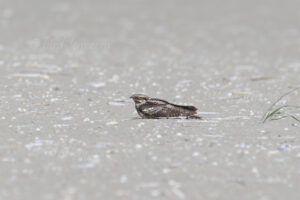 in the middle of broad daylight at the beginning of June, a dark brown something flies over the water in the glistening sunlight. It then lands in the middle of a sandy beach near St. Peter-Böhl on the german North Sea coast 100 km north-west of Hamburg. The surprise is great: it is a Eurasian Nightjar (Caprimulgus europaeus). The bird that lets us approach up to about 30m. The bird is probably so exhausted from the flight over the estuary bay of the river Eider that it has to rest first. A remarkable observation that has not been repeated for me either.
in the middle of broad daylight at the beginning of June, a dark brown something flies over the water in the glistening sunlight. It then lands in the middle of a sandy beach near St. Peter-Böhl on the german North Sea coast 100 km north-west of Hamburg. The surprise is great: it is a Eurasian Nightjar (Caprimulgus europaeus). The bird that lets us approach up to about 30m. The bird is probably so exhausted from the flight over the estuary bay of the river Eider that it has to rest first. A remarkable observation that has not been repeated for me either.
However, this observation underscores the importance of bird migration for the Eurasian Nightjar. As a migratory bird, it winters as a trans-Saharan migrant in Sub-Sahara Africa. The winter roost of the nominate form occurring in Central Europe extends above all
through eastern Africa from southern Ethiopia and southern Sudan southwards to the Cape Province and Namibia. In small numbers, this subspecies also winters in West Africa from Cameroon and Nigeria to Sierra Leone and Guinea.
The Eurasian Nightjar is known for migrating at night and usually migrates singly. Occasionally, however, small groups of 3 to 5 specimens are also observed. And the above description shows that obviously active migration also takes place over hostile habitats during the day. However, the nightjar is also known as a migratory bird that crosses mountains, deserts, rainforest areas and probably also water on a broad front.
The migration back home actually starts at the end of February and especially in March. The majority of the first observations for Central Europe from Hungary to Poland fell in the last decade of April and the first decade of May. The main arrival in Central Europe falls in May. However, the passage lasts until the end of May or the beginning of June and fits very well into the schedule here. In southern Sweden e.g., the arrival of breeding nightjars falls at the end of May.
To meet the growing demand for top quality images of the rarer species of the Palearctic, Bird-lens.com strives to expand the range of images of birds not only of the western Palearctic. Trips to remote locations to take pictures of rare western Palearctic birds have been very successful. This meaningful picture is only a first impression of what you can find in the gallery in the “Picture Shop” very soon. Just message bird-lens.com if I can provide a picture.